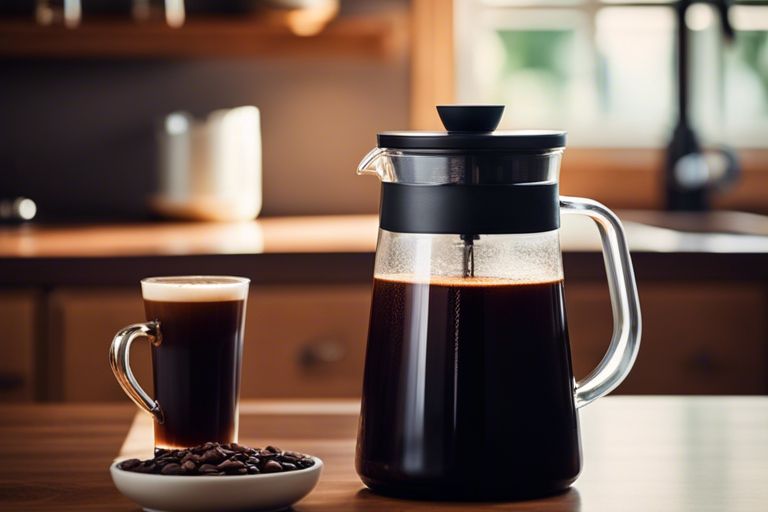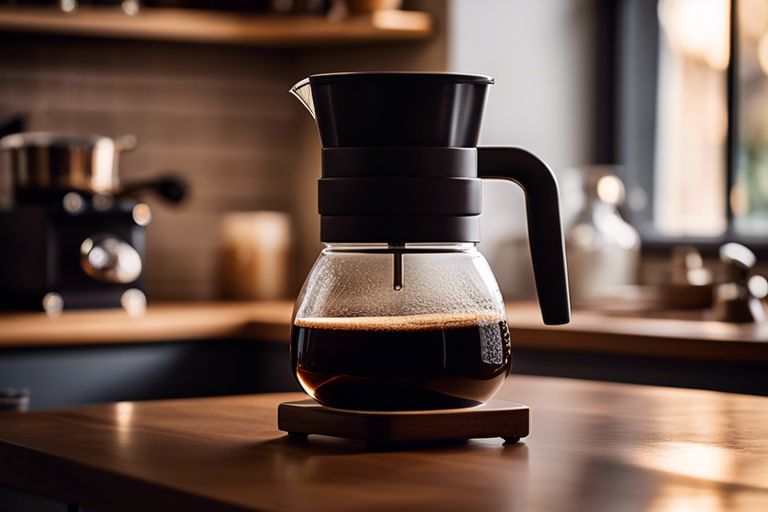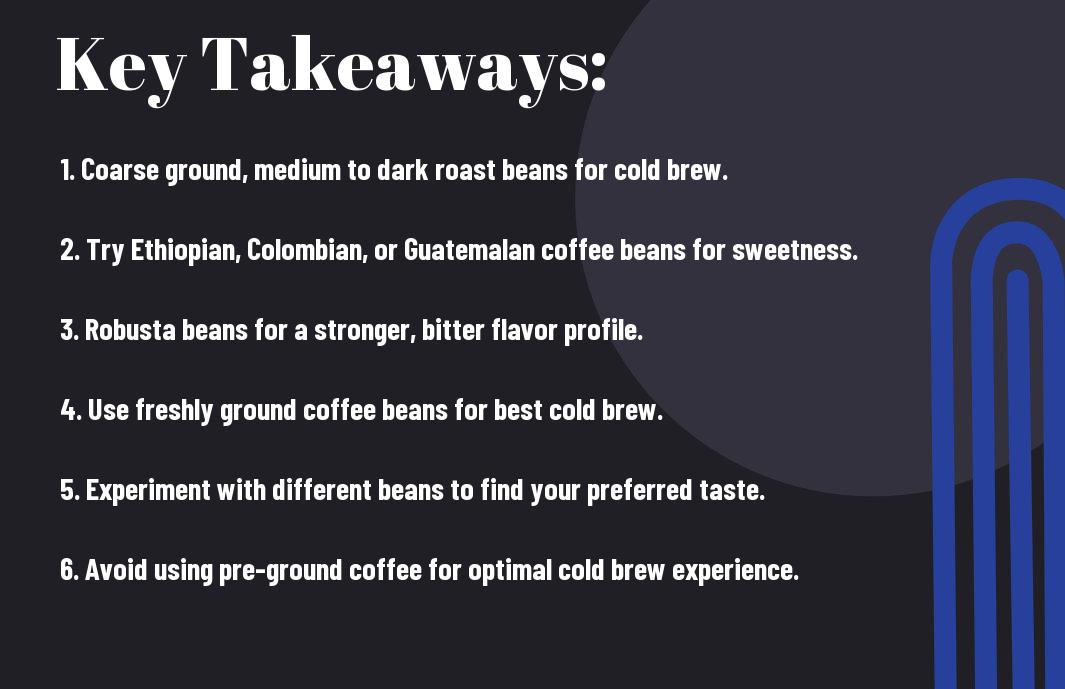Most coffee aficionados will agree that choosing the right beans is crucial for a perfect cold brew. The process extracts unique flavors, making bean selection crucial. Opt for a medium to coarse grind to maximize extraction and flavor. Lighter roasts offer fruity and floral notes, while darker roasts provide a rich, bold taste. Experiment with different origins and roasts to find the best coffee that suits your taste preferences for a refreshing cold brew experience.
Key Takeaways:
- Medium to dark roast: Opt for a medium to dark roast coffee for cold brew to bring out rich and bold flavors.
- Coarse grind: Use a coarse grind when preparing coffee for cold brew to prevent over-extraction and bitterness.
- Single-origin beans: Consider using single-origin beans for a more distinct and complex flavor profile in your cold brew.

The Basics of Cold Brew
What is Cold Brew Coffee?
Basics. Cold brew coffee is a method of brewing coffee that utilizes cold water over an extended period of time, typically around 12-24 hours. The slow extraction process results in a smooth, less acidic coffee concentrate that is often served over ice or diluted with water or milk.
How is Cold Brew Coffee Made?
Cold. To make cold brew coffee, coarsely ground coffee beans are steeped in cold water for an extended period. The ratio of coffee to water can vary, but a common ratio is around 1:4. After steeping, the coffee is then filtered to remove the grounds, resulting in a cold brew concentrate that can be stored and diluted as needed.
For instance, cold brew coffee can be enjoyed on its own or used as a base for various coffee beverages like iced lattes or coffee cocktails. Its versatility and smooth flavor profile make it a popular choice for coffee lovers looking for a refreshing alternative to hot coffee drinks.
Coffee Bean Selection
There’s a crucial decision to make when selecting beans for your cold brew – the type of coffee bean. Two primary varieties are commonly used in coffee production: Arabica and Robusta. Each type has its own characteristics that can impact the flavor profile of your cold brew.
Arabica vs. Robusta: Which is Better for Cold Brew?
Robusta beans are known for their strong and bold flavor profile, making them a popular choice for those who prefer a more intense cold brew. On the other hand, Arabica beans are favored for their smoother and more nuanced flavors, which can lend a more complex taste to your cold brew.
Single-Origin vs. Blends: Does it Matter?
Coffee aficionados often debate whether using single-origin beans or blends makes a difference in cold brew. Single-origin beans come from a specific region and are prized for showcasing the unique flavors of that area. On the other hand, blends combine beans from different regions to create a well-balanced flavor profile.
Bean selection can play a significant role in the overall taste of your cold brew. Consider experimenting with different bean varieties to find the perfect balance of flavors that suits your preferences.
Roast Levels for Cold Brew
Light Roasts: Bright and Fruity
Unlike other brewing methods, cold brew tends to mellow out the acidity in coffee, making light roasts a popular choice for those who enjoy a bright and fruity flavor profile. For cold brew, light roasts often bring out the subtle citrus notes and floral aromas for a refreshing and vibrant cup.
Medium Roasts: Balanced and Smooth
Light roasts might be too delicate for some cold brew enthusiasts, leading them to opt for medium roasts that offer a more balanced and smooth taste. Lighter than dark roasts but with more body than their lighter counterparts, medium roasts bring out a harmonious blend of flavors that are well-suited for the cold brewing process.
Medium roasts also preserve the bean’s natural characteristics while adding a touch of caramel sweetness, providing a satisfying depth of flavor without overwhelming the palate.
Dark Roasts: Rich and Bold
On the opposite end of the spectrum, dark roasts are favored by those who prefer a rich and bold coffee experience in their cold brew. These roasts bring out deep, smoky notes with a robust body that stands up well to the cold brewing process.
Another advantage of using dark roasts for cold brew is the intense and complex flavor profile they provide, making for a decadent and indulgent cup of coffee that is perfect for those who enjoy a more robust brew.
The Role of Acidity in Cold Brew
Once again, acidity plays a crucial role in determining the overall taste profile of cold brew coffee. While acidity is often associated with sourness, in the case of cold brew, it can actually enhance the flavors and bring a bright and vibrant quality to the brew.
How Acidity Affects Flavor Profile
Acidity in cold brew coffee can add a pleasant tanginess that balances out the natural bitterness of coffee beans. It can also provide a refreshing quality and enhance the fruity or floral notes present in the beans, creating a more complex and dynamic flavor profile.
Coffee Regions with High Acidity
Acidity in coffee is influenced by various factors, including the coffee bean variety, growing altitude, and processing methods. Some coffee regions are known for producing beans with high acidity, such as Ethiopia, Kenya, and Colombia. These beans are prized for their bright and lively acidity, which can make them ideal choices for cold brew coffee.
Brewing cold brew coffee using beans from these regions can result in a deliciously tangy and nuanced brew that showcases the natural acidity of the beans. Experimenting with different coffee origins can help you discover your preferred acidity levels and flavor profiles in cold brew coffee.
Body and Texture in Cold Brew
How Body Affects the Drinking Experience
For a cold brew enthusiast, the body of the coffee plays a crucial role in enhancing the overall drinking experience. The body refers to the weight and mouthfeel of the coffee, which can range from light and tea-like to heavy and syrupy. A coffee with a full body tends to have a richer, creamier texture that coats the palate with each sip, providing a more satisfying and indulgent feel.
Coffees with Heavy, Smooth Bodies
Brewing cold brew with coffees that have heavy, smooth bodies can result in a luscious and velvety beverage that delights the senses. These coffees are often low in acidity and high in sweetness, offering a decadent and dessert-like quality to the cold brew. The heavy body helps to balance out the mellow, smooth flavors, creating a harmonious and comforting drinking experience.
Another benefit of using coffees with heavy, smooth bodies for cold brew is the prolonged enjoyment of flavors. The dense body allows the flavors to linger on the palate, providing a more lingering and satisfying drinking experience.

Flavor Profiles for Cold Brew
Keep Coffee bean brands for cold brew in mind when selecting the best coffee for your cold brew. Different coffee beans offer unique flavor profiles that can greatly impact the taste of your cold brew.
Fruity and Floral Notes
Flavor is necessary when choosing the best coffee for cold brew. Some coffee beans boast fruity and floral notes that can add a refreshing and vibrant touch to your cold brew. Look for beans with hints of berries, citrus, or floral undertones for a delightful flavor profile.
Chocolatey and Nutty Notes
Brew your cold brew coffee with beans that feature chocolatey and nutty notes for a rich and satisfying flavor. These beans often have hints of cocoa, hazelnut, or almond, providing a decadent and comforting taste to your cold brew.
This flavor profile is perfect for those who enjoy a more indulgent and creamy cold brew experience. The deep, roasted notes of chocolate and nut flavors can create a velvety smoothness in every sip.
Earthy and Herbal Notes
Any cold brew aficionado knows the importance of considering the earthy and herbal notes in coffee beans. These beans offer a more grounded and robust flavor profile, with hints of spices, tobacco, or herbs that can add complexity to your cold brew.
Cold brew enthusiasts looking for a bold and intense flavor experience should explore coffee beans with earthy and herbal notes. These beans can provide a deep and soulful dimension to your cold brew, making each sip a journey through rich, earthly flavors.

To wrap up
On the whole, when it comes to choosing the best coffee for cold brew, it’s important to remember that personal preference plays a significant role. However, darker roasts tend to be favored for their bold and smooth flavor profile, while single-origin beans allow for a more unique and nuanced taste. Experimenting with different beans and adjusting the grind size can help you find the perfect balance that suits your taste buds. So grab a bag of your favorite beans, cold brew them overnight, and enjoy a refreshing and flavorful cup of coffee that is sure to awaken your senses.
FAQ
Q: What type of coffee is best for cold brew?
A: The best coffee for cold brew is a coarse grind of medium to dark roast beans. These beans are known for their rich and bold flavors that hold up well during the long steeping process.
Q: How long should I brew cold brew coffee?
A: For the best results, cold brew coffee should be steeped for 12-24 hours. This extended brewing time allows the flavors to fully develop, resulting in a smooth and concentrated brew.
Q: What is the ideal ratio of coffee to water for cold brew?
A: The ideal ratio for cold brew coffee is 1:4, which means 1 part coffee to 4 parts water. This balanced ratio ensures that the coffee is strong enough to stand out against the diluting effect of the ice or milk typically added when serving.
Q: Can I use any type of water to make cold brew coffee?
A: It is recommended to use filtered water when making cold brew coffee to avoid any off-flavors that may be present in tap water. The quality of water can greatly impact the final taste of your cold brew.
Q: How long does cold brew coffee last in the refrigerator?
A: Cold brew coffee can last up to two weeks when stored in an airtight container in the refrigerator. Its concentrated nature allows it to maintain its freshness and flavor longer than traditional brewed coffee.








